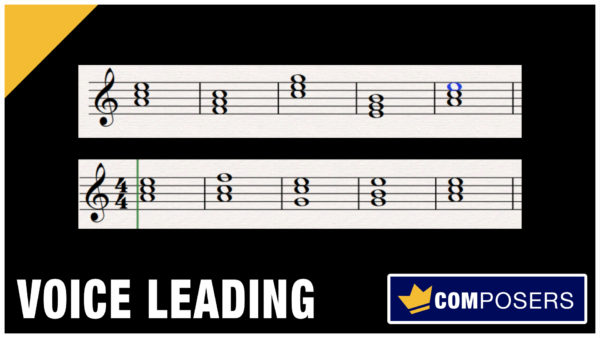 Have you ever played a chord progression and although it sounded good, it just didn’t seem to flow. Welcome then to the world of voice leading.
Have you ever played a chord progression and although it sounded good, it just didn’t seem to flow. Welcome then to the world of voice leading.
This term simply means to move smoothly from one set of harmony to the next. In this article I will be taking you through a simple method of smoothing out your chord progressions.
A lot of electronic music is written in the minor mode, the majority of which happens to be to be in A minor (all the white notes) no coincidence why this is then. The example provided are all chords that can be found within the A natural minor scale.
Let us start by constructing our A minor chord (notes: A, C, E) and then move to the VI chord. The roman numeral VI is shorthand for describing that the chord is based on the 6th note of the A minor scale, the capitals reference that this is a Major chord. Therefore the 6th note of the scale A minor is F, and the F Major chord is made using (notes: F, A, C).
Moving from there we go to the III chord. The third note of the A minor scale is C, and the C Major chord is made using (notes: C, E, G). If we carry this on by one more chord to the v chord we get E minor (notes: E, G, B), the v denotes it is the fifth note of the scale and is a minor chord. We now have a very simple chord progression that leads us back to the A minor; our starting chord.
Now, we could simple move through the chords using them in root position. If we look at the C Major chord the root position would start on the note C, the v chord on the note E, e.t.c. There is nothing wrong in doing this but when you play the progression it sounds disjointed and there would be a lot of jumping around up and down the keyboard, as fig 1. Shows:

To smooth out the progression we use voice leading. The first rule when looking at moving from one chord to the next in a smooth fashion is to use the notes in common. If we move from A minor to F Major we need to consider the notes in each chord.
A minor contains (A, C, E) whereas F Major contains the notes (F, A, C). What notes do we have in common……… there is the A and C. Therefore we would place the Major chord in its first inversion, this is achieved by building the chord on the 2nd note of the root position chord. The F Major chord will then look like this (A, C, F).
We now need to move from the F Major Chord to the C Major chord. What notes do we have in common……… there is just the note C. To get the smoothest movement you will want to look at how far you are moving your hand and fingering from the F chord to the C chord. The smoothest and shortest travel is to go from F Major (A, C, F) to C Major (G, C, E).
We have now successfully moved to the second inversion of the C Major chord. This is because the chord has been built on the third note of a root position C Major Chord (C, E, G).
We continue to follow this method of least travel as the chord moves from C Major to E minor. So on the C chord we are playing (G, C, E) the E minor chord could then be made by building the chord on (G, B, E). This is because we have the notes G and E in common and so they should remain static.
To bring this short sequence to a resolution we now need to move back to A minor from the E minor chord. So for the final time we look at the notes in common of A minor (A, C, E) and E minor (G, B, E) – remember we have our chord in the second inversion. Normally a piece of music or chord progression ends on the tonic note of the chord so we move the note G to A, the note B to C and keep the E where it is.
Our little chord progression can therefore be notated as shown in fig 2. Below:

Try playing the progression shown in fig 1. and compare this with that in fig 2. I think you will agree the one in fig 2. sounds smoother and is far easier to finger on the keyboard.
If you want to dive deeper, learn more and connect with professional composers, join the Professional Composers Community on Facebook here.
 Thanks to Adrian Earnshaw for writing this article! =)
Thanks to Adrian Earnshaw for writing this article! =)
Please check out his amazing music, and follow and support him on his social media channels:
